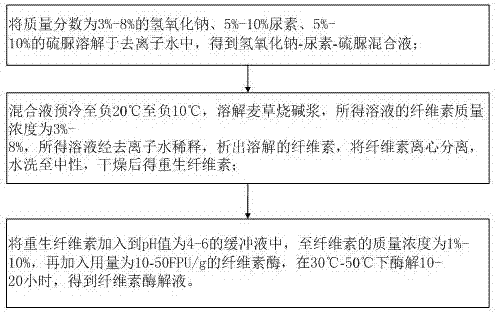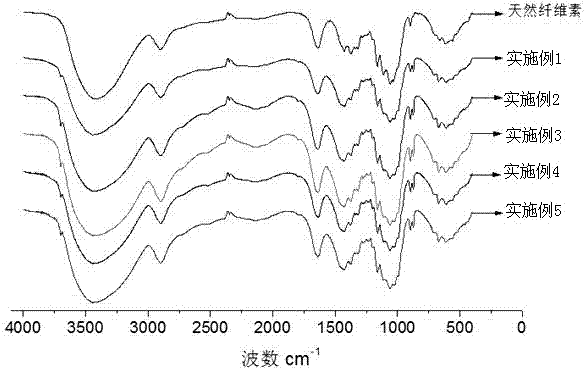Pretreatment method for improving straw cellulose saccharification rate
A technology of straw cellulose and cellulose, which is applied in the field of enzymatic hydrolysis and saccharification treatment, can solve the problem of high consumption cost and achieve the effects of eliminating biological resistance, simple process and simple operation.
- Summary
- Abstract
- Description
- Claims
- Application Information
AI Technical Summary
Problems solved by technology
Method used
Image
Examples
Embodiment 1
[0028] Prepare sodium hydroxide with a mass fraction of 4%, 6% urea and 5% thiourea and dissolve them in deionized water to obtain a sodium hydroxide-urea-thiourea mixture; pre-cool the mixture to -10°C to Dissolve wheat straw caustic soda pulp to prepare a straw cellulose solution with a mass fraction of 3%. The resulting solution is diluted with water to precipitate 80% of the dissolved cellulose, centrifuged twice at 3000rpm / min to separate the cellulose, and washed with water until the pH value is 7.2. After air-drying, light yellow, fibrous regenerated cellulose is obtained; the regenerated cellulose is added to the acetic acid-sodium acetate buffer solution with a pH value of 4.5, until the mass concentration is 10%, and then cellulase is added, and the enzyme dosage is 10 FPU / g, Enzymolysis at 30°C for 10 hours to obtain a cellulose enzymatic solution containing a large amount of reducing sugar, and the saccharification rate of cellulose was measured to be 68.5%;
[00...
Embodiment 2
[0031]Dissolve 8% sodium hydroxide, 10% urea and 10% thiourea in deionized water to obtain a sodium hydroxide-urea-thiourea mixture; pre-cool the mixture to -20 °C to dissolve wheat straw Using caustic soda pulp, a straw cellulose solution with a mass fraction of 5% was obtained; diluted with water, 90% of the dissolved cellulose was precipitated, the cellulose was centrifuged at 4000rpm / min, washed with water to a pH value of 7.0, and light yellow was obtained after drying in an oven , fibrous regenerated cellulose; the regenerated cellulose is added to the acetic acid-sodium acetate buffer solution with a pH value of 5.5 to a mass concentration of 3%, then cellulase is added, and the enzyme dosage is 30 FPU / g, at 40°C After 20 hours of enzymatic hydrolysis, a cellulose enzymatic solution containing a large amount of reducing sugar was obtained, and the saccharification rate of cellulose was measured to be 94.1%;
[0032] Set up a control sample, use the same cellulase dosage...
Embodiment 3
[0034] Take 7% sodium hydroxide, 8% urea and 8% thiourea and dissolve them in deionized water to obtain a sodium hydroxide-urea-thiourea mixture; pre-cool the mixture to -12°C to dissolve the wheat straw A straw cellulose solution with a mass fraction of 5% was prepared from caustic soda pulp; diluted with water, 90% of the dissolved cellulose was precipitated, centrifuged at 5000rpm / min to separate the cellulose, washed with water to a pH value of 7.1, air-dried and then oven-dried to obtain Light yellow, fibrous regenerated cellulose; add regenerated cellulose to citric acid-sodium citrate buffer solution with a pH value of 6.0 to a mass concentration of 5%, then add cellulase, and the enzyme dosage is 35 FPU / g , enzymatically hydrolyzed at 50°C for 15 hours to obtain a cellulose hydrolyzate containing a large amount of reducing sugar, and the saccharification rate of cellulose was 92.4%;
[0035] Set up a control sample, use the same cellulase dosage of 35FPU / g, the same ce...
PUM
 Login to View More
Login to View More Abstract
Description
Claims
Application Information
 Login to View More
Login to View More - R&D
- Intellectual Property
- Life Sciences
- Materials
- Tech Scout
- Unparalleled Data Quality
- Higher Quality Content
- 60% Fewer Hallucinations
Browse by: Latest US Patents, China's latest patents, Technical Efficacy Thesaurus, Application Domain, Technology Topic, Popular Technical Reports.
© 2025 PatSnap. All rights reserved.Legal|Privacy policy|Modern Slavery Act Transparency Statement|Sitemap|About US| Contact US: help@patsnap.com


